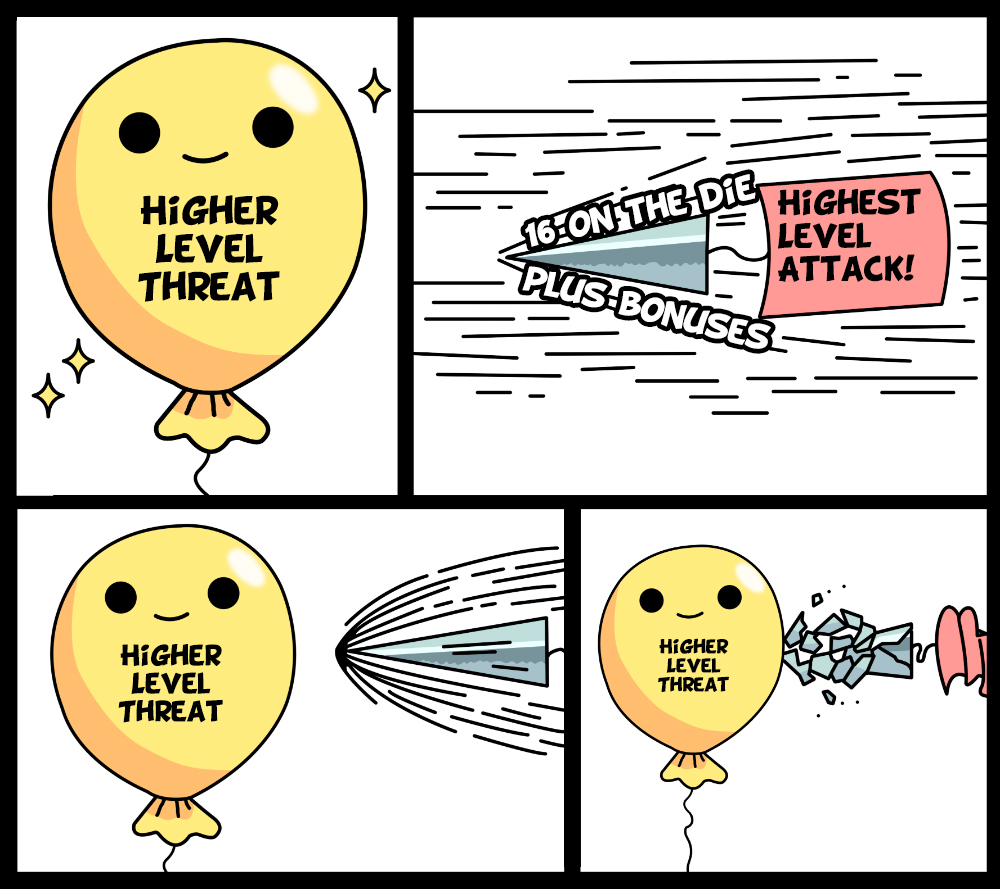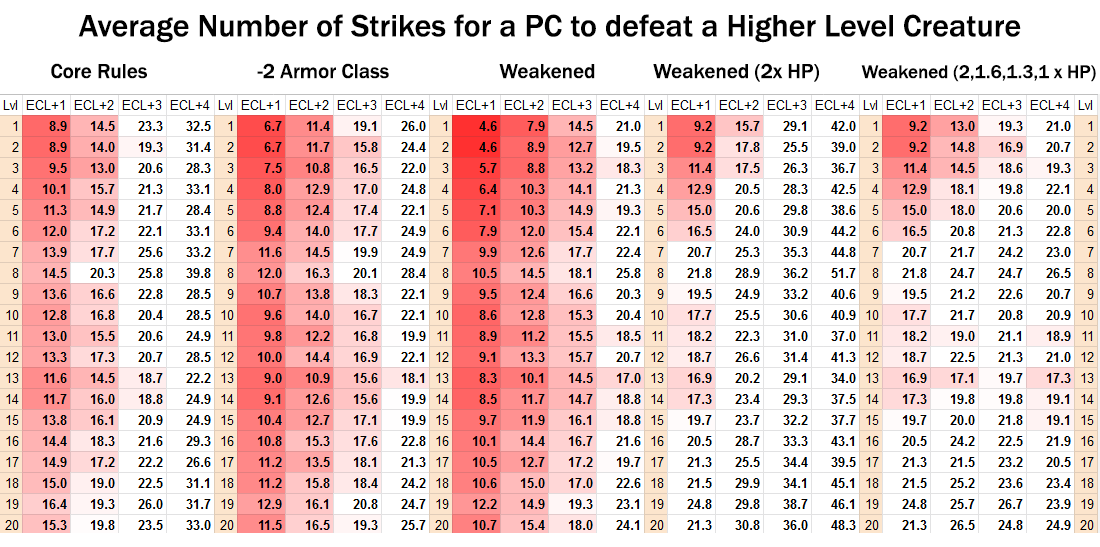“The only thing that sucks more than missing is the enemy laughing off three 19s in a row…”
Before you read this article I recommend you check out my last article: Adjusting Extreme Encounters. To summarize: Pathfinder 2e has some great math, but encounters against higher-level threats can quickly turn into a nightmare if you don’t prepare for them! Especially if you are running APs, you must keep your party’s composition in mind and certain adjustments to a monster’s stat block and tactics can make the difference between a narrow victory and an absolute slaughter. Last time we went over some ways you can adjust a monster’s attacks so critical hits are less oppressive. This week we are going to look over adjusting a monster’s defense!
The Problem
The first chart uses the core rules. The others are variants I will present below.
Higher-level enemies require a ton of hits to take out. While you get 3-attacks per round, you should rarely attempt a third attack, especially when higher-level threats hit that much harder and therefore require more tactics beyond pure damage. The above charts assume you are dealing above-average (but not optimal) damage against a monster with average AC and above-average HP (to account for resistances and higher-level defensive abilities than your offensive abilities). The math in these fights heavily favors the monsters, especially in severe- and extreme-level threats where your normal tactical advantages are minimized as you rarely score a critical hit on a 19 even with additional buffs!
ECL+1 threats aren’t too bad. A four-person party can usually take them out in a little more than 3 rounds, but it takes 6 Strikes from that monster to take a PC to 0 HP. While this will extend the combat to a solid 4 rounds, that is the median average of how long most game groups want their combat to last. ECL+2 threats take around 6 rounds, and ECL+3 threats take around 8 rounds (and require some luck). But ECL+4 threats are nigh impossible, taking >29 strikes and dispatching a PC every 3.5 attacks. This means you will need a party of 8 PCs to reliably take down this monster, and you will very likely end the fight with only 1 PC standing!
Solo enemies need extra defense. A party still has more combined actions per round than the solo enemy. While you statistically need 8 PCs to take out an ECL+4 enemy, in actual play class features that offset MAP and pure action economy can easily offset this number. The increased defenses give your monster the ability to survive the first ~2 rounds of combat so they can use more engaging tactics than spewing out raw damage.
But an impossible challenge invites a negative play experience. Even if you aren’t playing a fighter, missing above a 15 feels bad. While high AC is a valid way to improve the defenses of a monster, against large solo threats it makes parties feel nigh-useless even if they were able to take out the monster on action-economy alone. Every extra round a battle lasts is another opportunity for a monster to score a dangerous critical hit, and fewer opportunities for the PCs to turn the battle around as the monster knocks out more PCs.
The Solutions
These Solutions Aren’t for Everyone. Use the above charts as a tool and keep in mind how many damage-dealing strikers are in your party. Consider whether or not your party is the type that tries for multiple attacks or tries to win using battlefield control and action manipulation strategies. If your PCs rely more on saving throws than AC, you will need to take a different approach to balance your encounters. Try a “test run” using a PCs mentor or an exhibition match to get a feel for your party’s strengths and weaknesses in an arena in town before your PCs are out in the wilderness hunting down their first dragon.
Optional Rule 1: Weak Adjustment.
Apply the weak adjustment, applying a permanent -2 penalty and lowering a monster’s base Hit Points.
Advantages: This is easy to apply using Archives of Nethys’ built-in monster adjustment tool and can easily turn a 6-8 round slog into a 4-5 round combat.
Disadvantages: This can make some monsters too easy, especially those that already have low AC and/or are reliant on defensive abilities that they might not be able to fully implement before they get completely crushed by a well-prepared or lucky party. This can make what was meant to be an important battle feel somewhat lackluster. You probably shouldn’t apply the weakened template if you are already adjusting a monster’s critical hits to be less deadly using my other article! (See: Exceptions.)
-2 Armor Class Exception: Try just lowering a monster’s Armor Class without any other adjustments (chart 2). This will give player’s the opportunity to score critical hits by using tactical buffs, and may be just the adjustment you need against high-AC monsters.
Double Hit Points Exception: I’ve heard good things about groups that give solo-threats the weak adjustment, then double their HP. It makes the monster last long enough to use some less-optimal full-round actions knowing it has those extra hit-points, while still lowering its AC enough that the PCs can feel like great big heroes rolling all those damage dice!
Variable Hit Points Exception: I find this variation on the “Double Hit Point” exception a good middle ground that scales ECL+3/+4 encounters better. With this rule, make the following adjustments to your monsters:
• ECL+1: -2 to AC, Weaken then Double Hit Points
• ECL+2: -2 to AC, Weaken then 1.6 x Hit Points
• ECL+3: -2 to AC, Weaken then 1.3 x Hit Points
• ECL+4: -2 to AC, Weaken (Use Standard Weakened Hit Points)
Optional Rule 2: Weak Spot Adjustment.
This rule makes a monster more vulnerable as it fights by weakening its armor each time it is hit. Whenever a PC hits a monster with a Natural 15 or higher on the die but fails to score a critical hit, the monster increases its Weakness value by 1. If the PC has any Multiple Attack Penalty, they must roll a 19 or higher. PCs score a critical hit against a monster if the result of their attack exceeds the target’s AC by 10 minus the monster’s Weakness.
Advantages: This makes it more likely that surviving PCs can still defeat a monster, especially once the more powerful front-line fighters are knocked unconscious. It makes buffs more powerful by allowing for critical hits against powerful enemies without having to roll a 20. It also adds a level of verisimilitude as players thematically attack the same point again and again on a well-armored monster until it falls.
Disadvantages: This adds additional paperwork for a GM who has to manually adjust a monster’s AC and check for PCs rolls on each attack. Since it only applies to critical hits, it can also be skewed by parties using effects like Deadly and Fatal and may require further adjustment.
Combat Maneuver Variation: With this variation, a PC can attempt a Skill Check against the monster. On a success, the next attack that hits the monster until the end of your next turn increases its Weakness value by 1. The nature of the check will vary but should target the Fortitude or Perception DC of a monster and provoke an Attack of Opportunity on a Critical Failure. If you want to make it a Secret Check, it can even decrease the Wounded Condition of a monster (as the PC points out an area where the monster isn’t vulnerable). This variation will require adjustment depending on the type of monster and nature of the campaign, and should only be considered in specific circumstances (such as skill-heavy parties) and not as a general campaign rule.
Conclusion
No solution is perfect. Like with my other suggestions, use these charts when designing the comfort level of your solo encounters, but realize that party preference, party composition, and monster specifics will cause all this data to go awry.
Watch for the Breakpoints: Monsters are slightly more bulky than you’d expect at certain breakpoints, especially level 8, 12, 16 & 20. Check the charts and look for sudden spikes in those numbers!
This still doesn’t account for saving throws: Casters are going to need their own article that will be forthcoming, as this doesn’t account for a monster’s vulnerabilities or weaknesses to magic. The fewer damage-dealing strikes a party does, the less useful this information will be for your table and the more you need to look into adjusting saving throws and resistances instead of AC!
In Conclusion. Pathfinder is about making the game your own and you should be eager and willing to adjust the rules if you find your group has more fun. I feel as though this rule alone doesn’t resolve all the problems my players have with severe- or extreme-threat encounters, but I’m going to leave that for my next article in this series where we conclude the series with tips on mooks, hazards, and adjusting for your party’s spellcasters!







